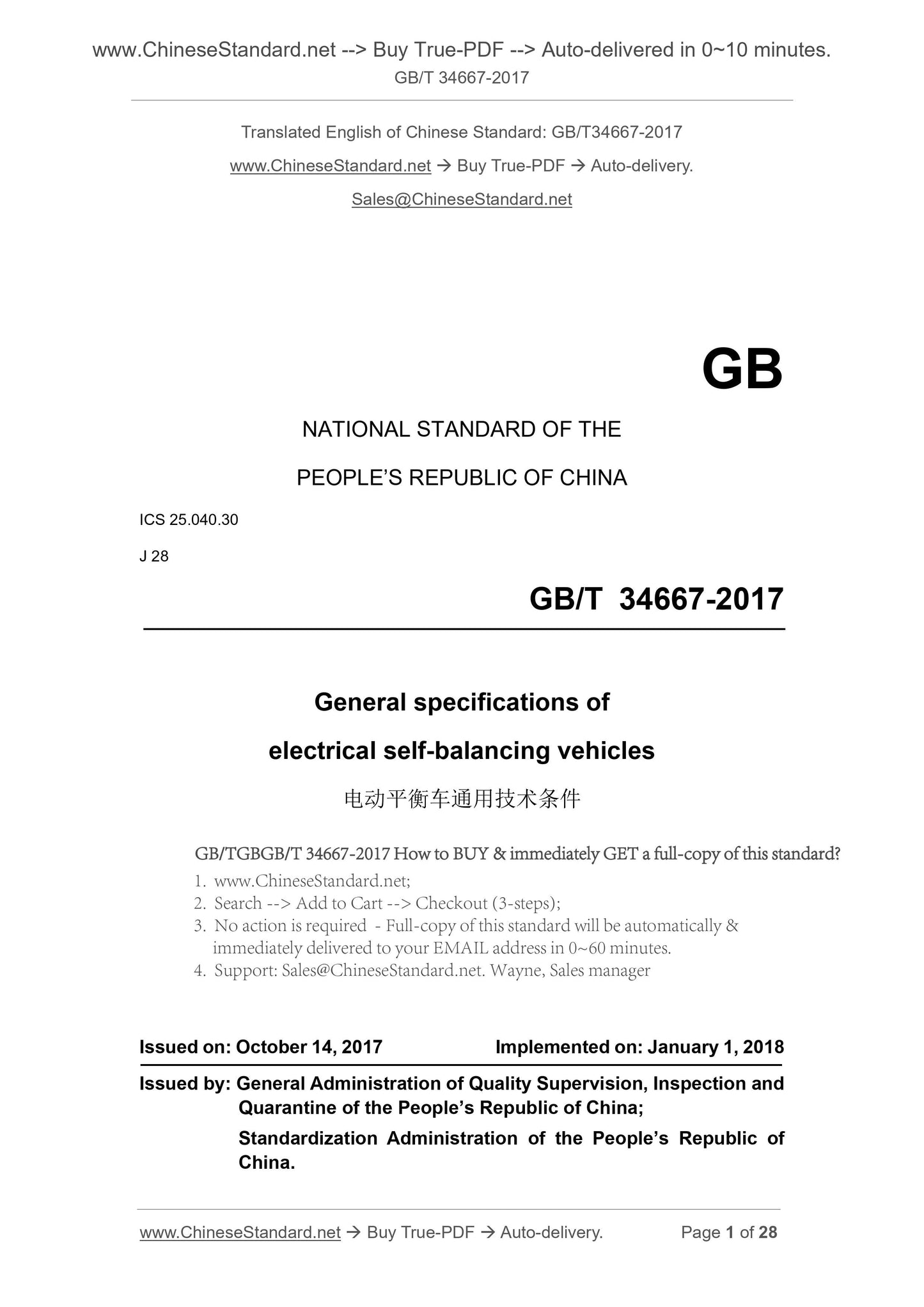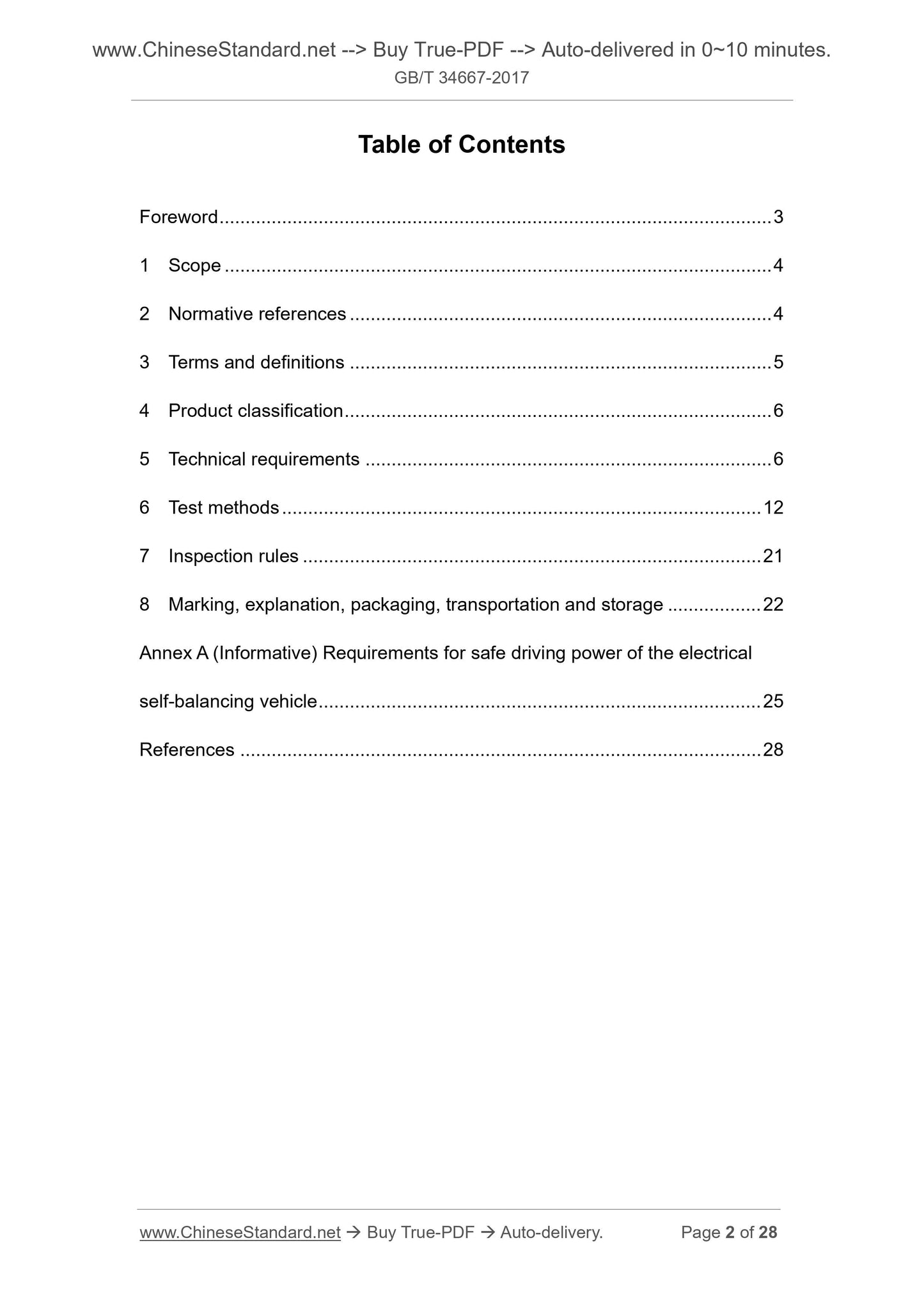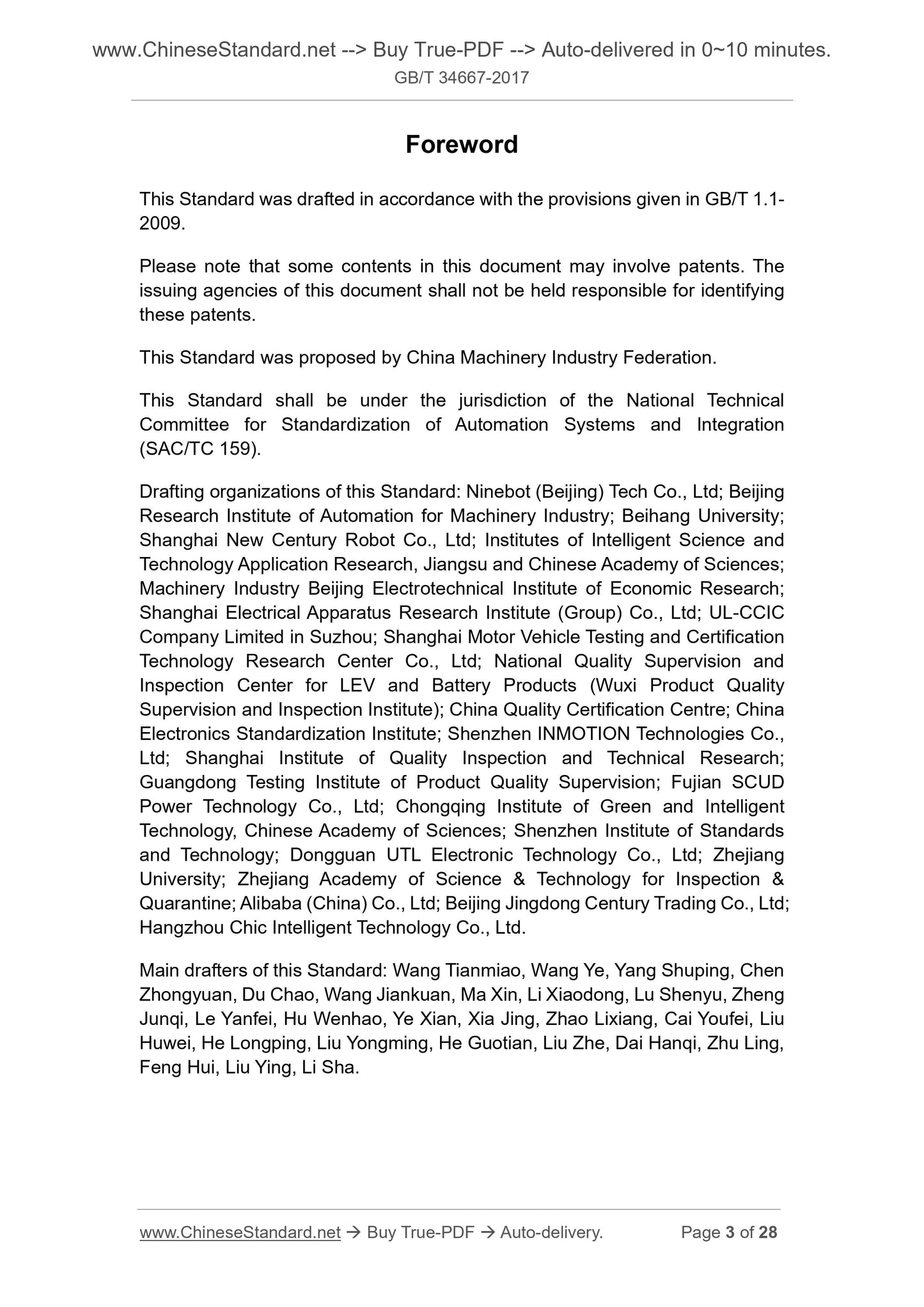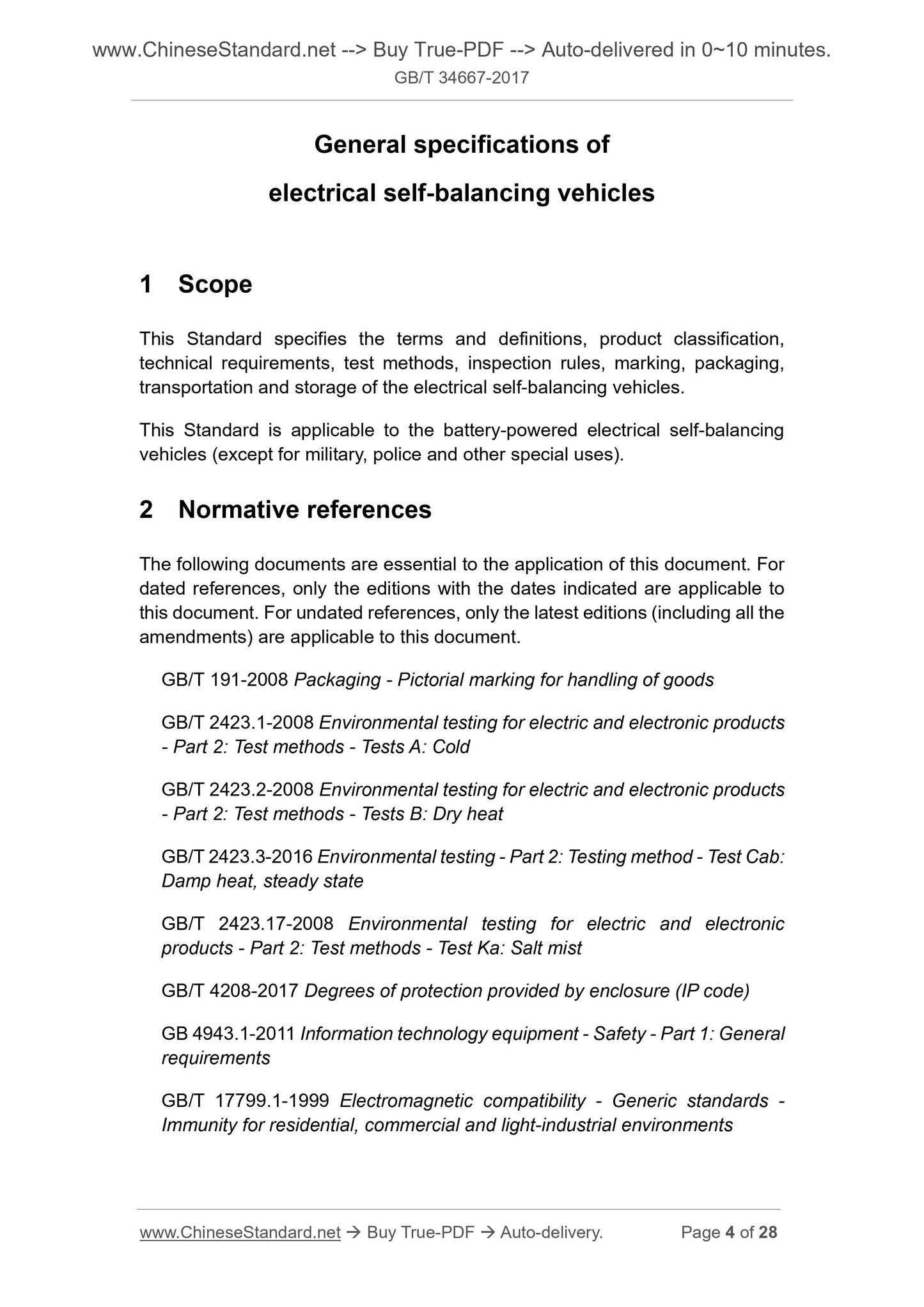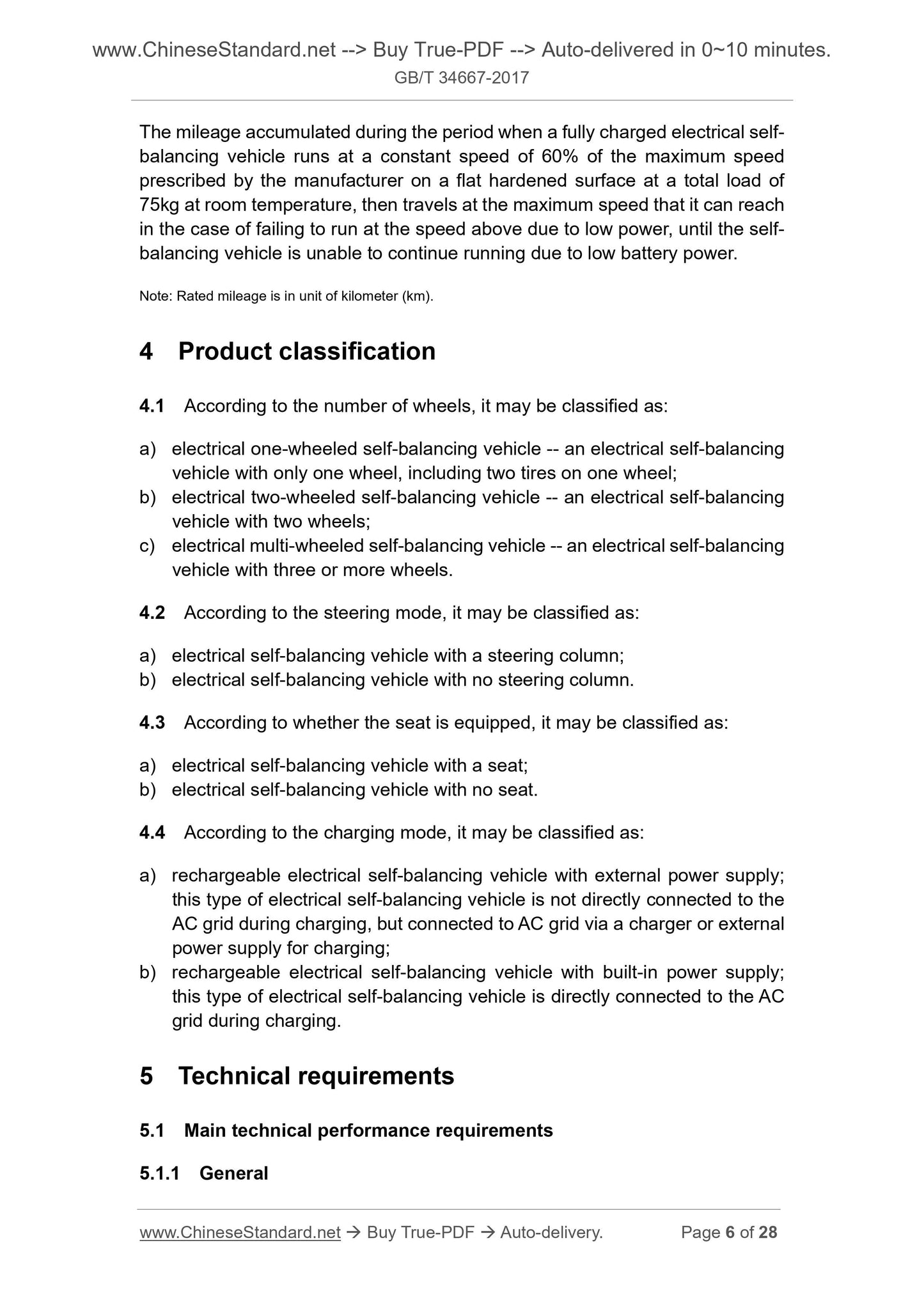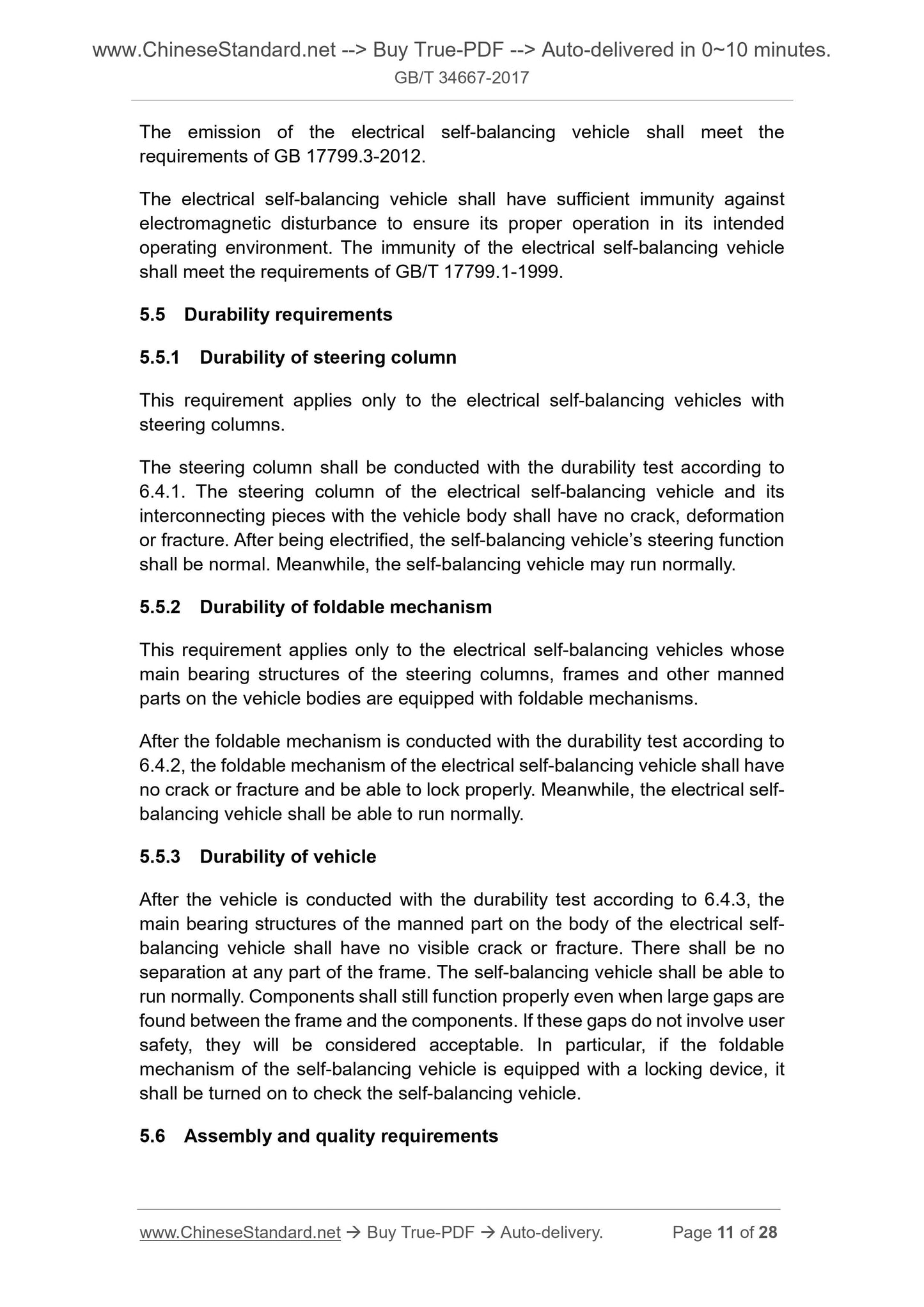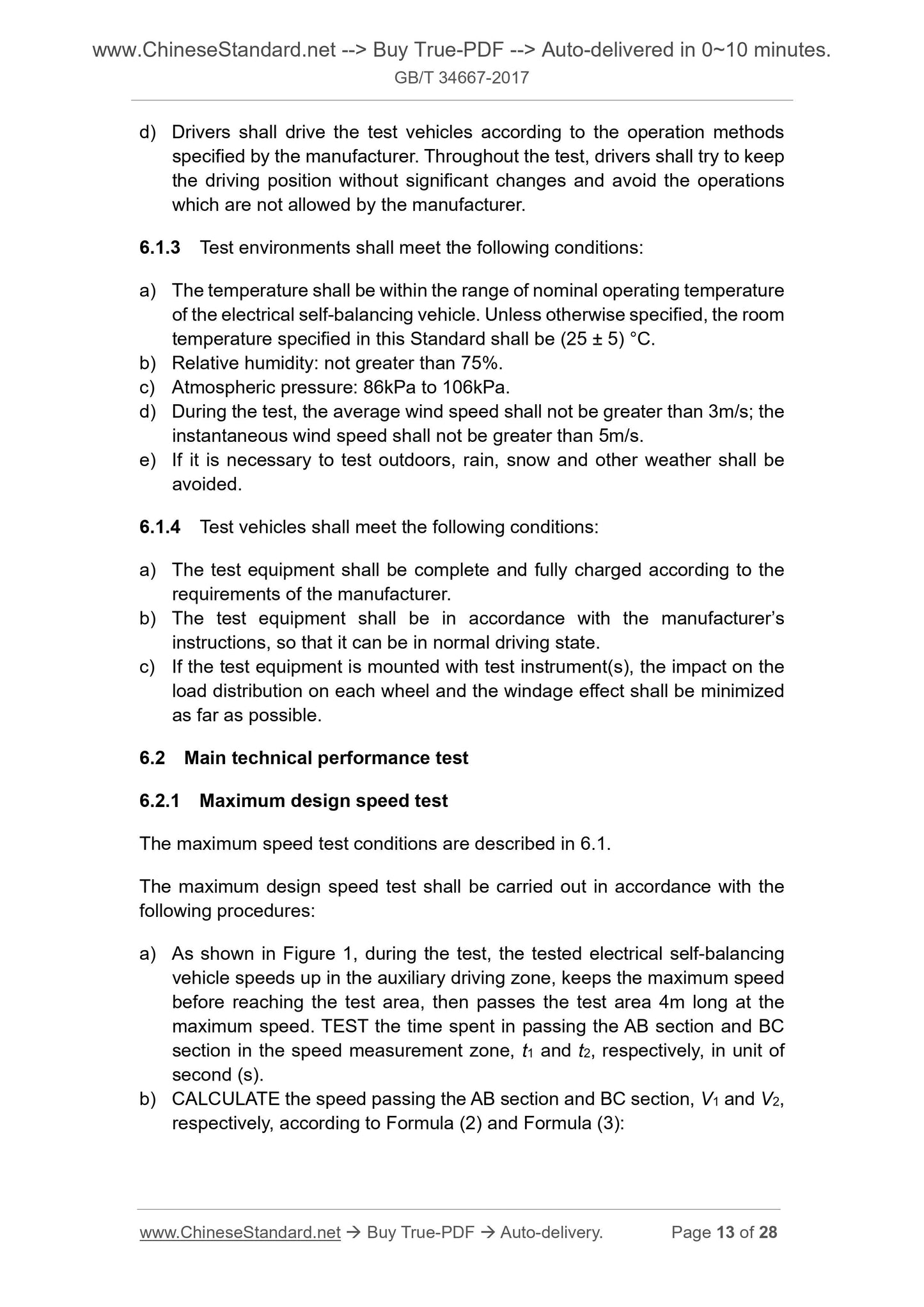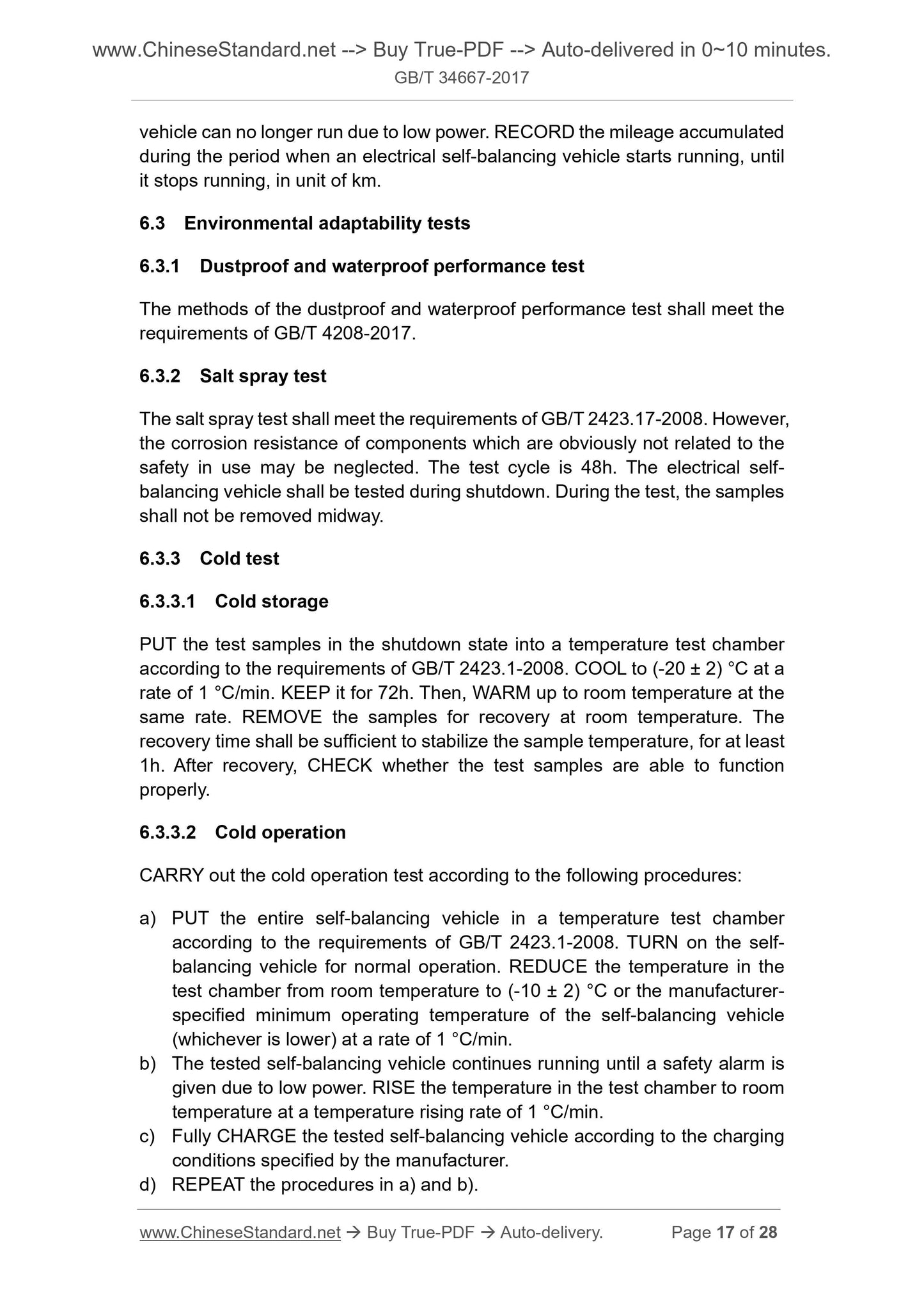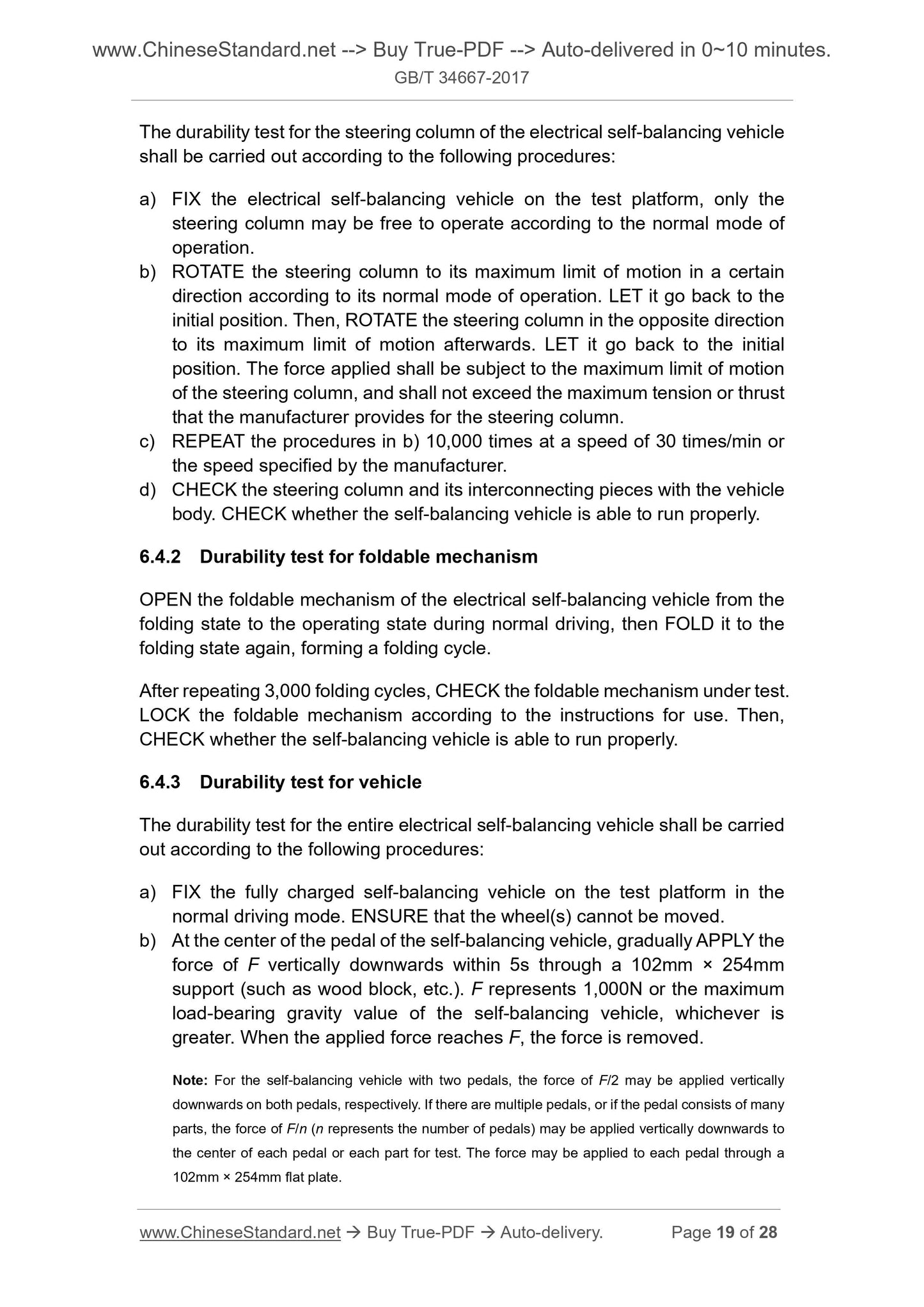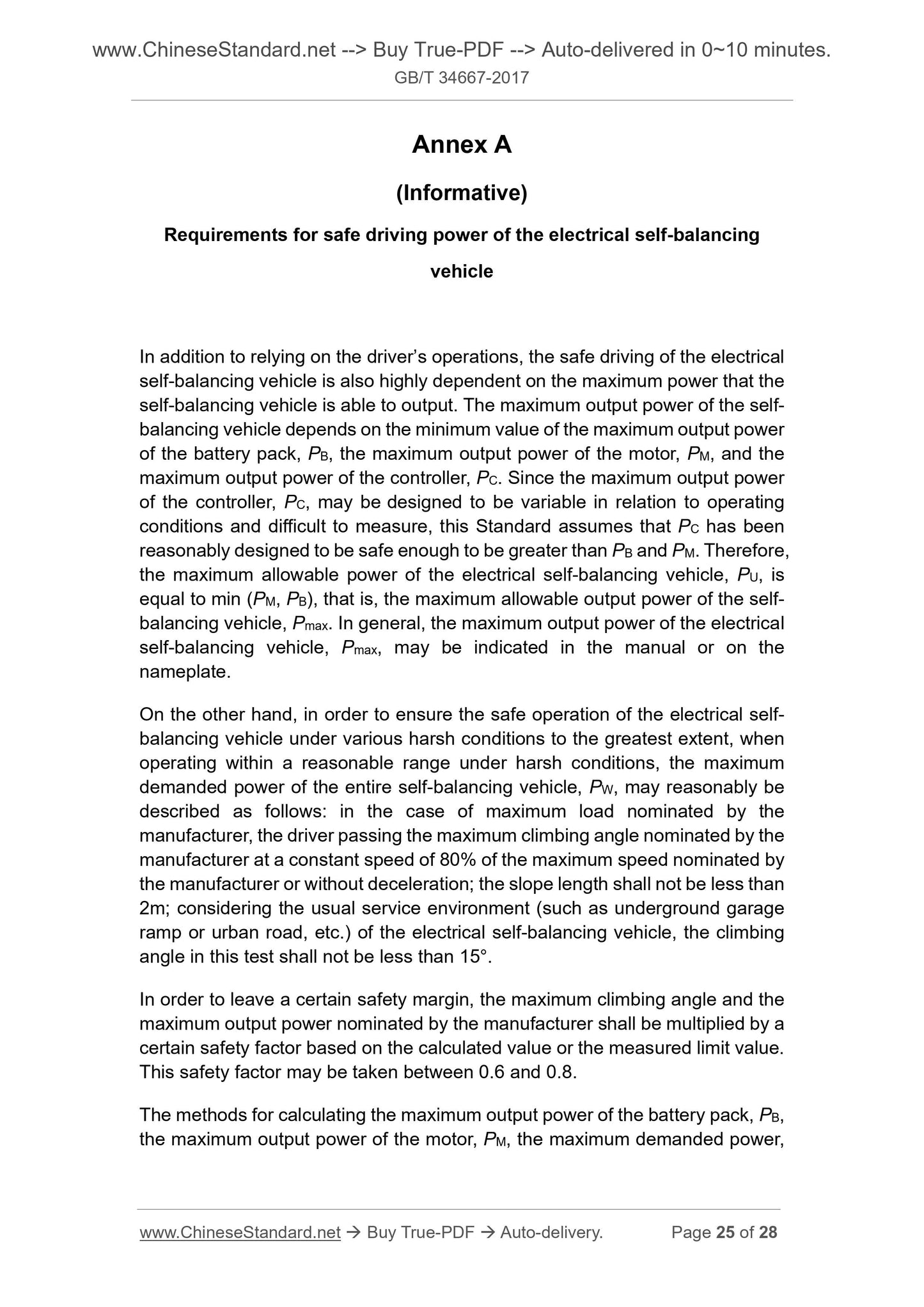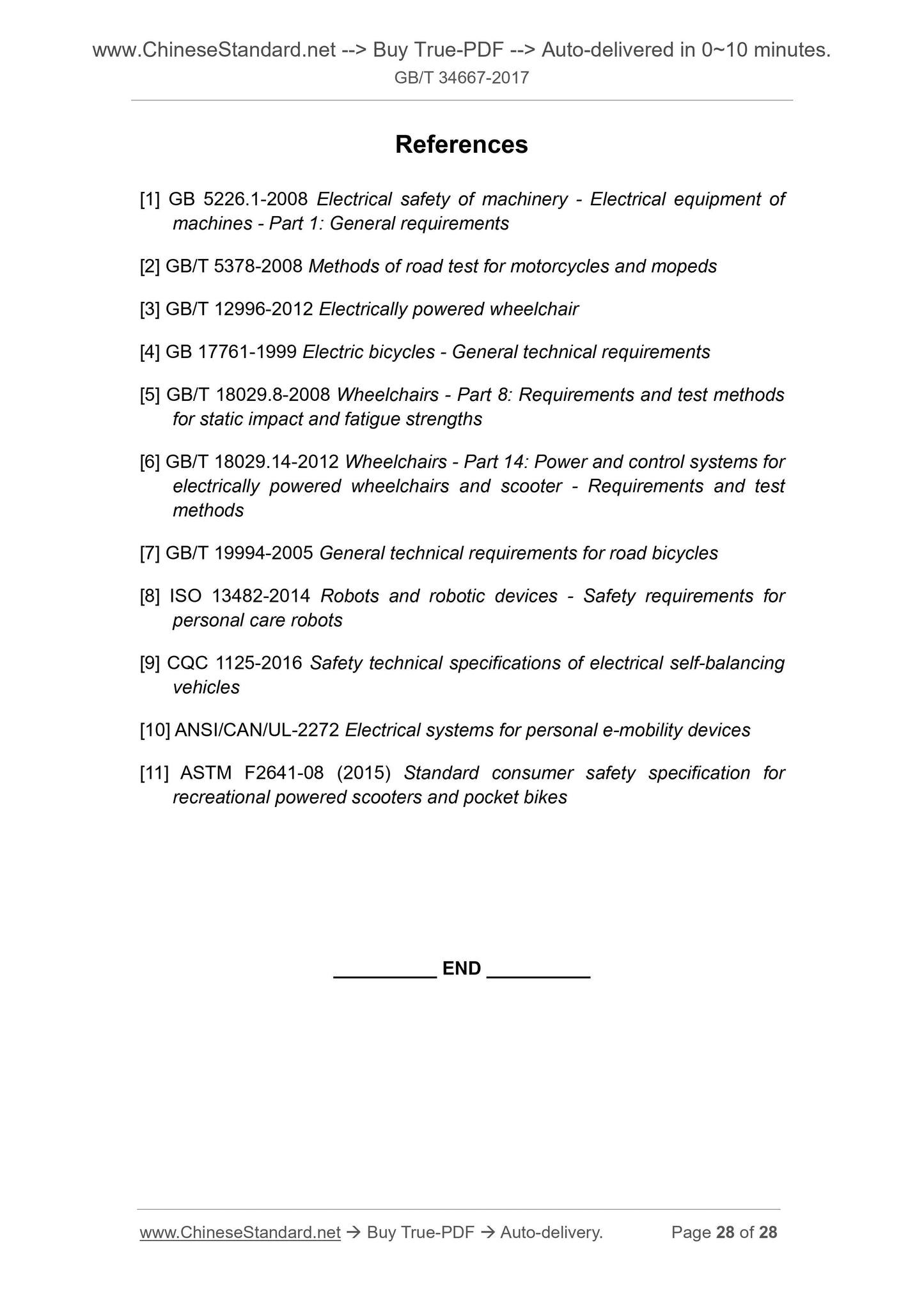1
/
of
11
PayPal, credit cards. Download editable-PDF & invoice in 1 second!
GB/T 34667-2017 English PDF (GBT34667-2017)
GB/T 34667-2017 English PDF (GBT34667-2017)
Regular price
$150.00 USD
Regular price
Sale price
$150.00 USD
Unit price
/
per
Shipping calculated at checkout.
Couldn't load pickup availability
Delivery: 3 seconds. Download true-PDF + Invoice.Newer version: (Replacing this standard) GB/T 34667-2023
Get QUOTATION in 1-minute: Click GB/T 34667-2017
Historical versions: GB/T 34667-2017
Preview True-PDF (Reload/Scroll if blank)
GB/T 34667-2017: General specifications of electrical self-balancing vehicles
GB/T 34667-2017
GB
NATIONAL STANDARD OF THE
PEOPLE’S REPUBLIC OF CHINA
ICS 25.040.30
J 28
General specifications of
electrical self-balancing vehicles
ISSUED ON. OCTOBER 14, 2017
IMPLEMENTED ON. JANUARY 1, 2018
Issued by. General Administration of Quality Supervision, Inspection and
Quarantine of the People’s Republic of China;
Standardization Administration of the People’s Republic of
China.
Table of Contents
Foreword ... 3
1 Scope ... 4
2 Normative references ... 4
3 Terms and definitions ... 5
4 Product classification ... 6
5 Technical requirements ... 6
6 Test methods ... 12
7 Inspection rules ... 21
8 Marking, explanation, packaging, transportation and storage ... 22
Annex A (Informative) Requirements for safe driving power of the electrical
self-balancing vehicle ... 25
References ... 28
Foreword
This Standard was drafted in accordance with the provisions given in GB/T 1.1-
2009.
Please note that some contents in this document may involve patents. The
issuing agencies of this document shall not be held responsible for identifying
these patents.
This Standard was proposed by China Machinery Industry Federation.
This Standard shall be under the jurisdiction of the National Technical
Committee for Standardization of Automation Systems and Integration
(SAC/TC 159).
Drafting organizations of this Standard. Ninebot (Beijing) Tech Co., Ltd; Beijing
Research Institute of Automation for Machinery Industry; Beihang University;
Shanghai New Century Robot Co., Ltd; Institutes of Intelligent Science and
Technology Application Research, Jiangsu and Chinese Academy of Sciences;
Machinery Industry Beijing Electrotechnical Institute of Economic Research;
Shanghai Electrical Apparatus Research Institute (Group) Co., Ltd; UL-CCIC
Company Limited in Suzhou; Shanghai Motor Vehicle Testing and Certification
Technology Research Center Co., Ltd; National Quality Supervision and
Inspection Center for LEV and Battery Products (Wuxi Product Quality
Supervision and Inspection Institute); China Quality Certification Centre; China
Electronics Standardization Institute; Shenzhen INMOTION Technologies Co.,
Ltd; Shanghai Institute of Quality Inspection and Technical Research;
Guangdong Testing Institute of Product Quality Supervision; Fujian SCUD
Power Technology Co., Ltd; Chongqing Institute of Green and Intelligent
Technology, Chinese Academy of Sciences; Shenzhen Institute of Standards
and Technology; Dongguan UTL Electronic Technology Co., Ltd; Zhejiang
University; Zhejiang Academy of Science and Technology for Inspection and
Quarantine; Alibaba (China) Co., Ltd; Beijing Jingdong Century Trading Co., Ltd;
Hangzhou Chic Intelligent Technology Co., Ltd.
Main drafters of this Standard. Wang Tianmiao, Wang Ye, Yang Shuping, Chen
Zhongyuan, Du Chao, Wang Jiankuan, Ma Xin, Li Xiaodong, Lu Shenyu, Zheng
Junqi, Le Yanfei, Hu Wenhao, Ye Xian, Xia Jing, Zhao Lixiang, Cai Youfei, Liu
Huwei, He Longping, Liu Yongming, He Guotian, Liu Zhe, Dai Hanqi, Zhu Ling,
Feng Hui, Liu Ying, Li Sha.
General specifications of
electrical self-balancing vehicles
1 Scope
This Standard specifies the terms and definitions, product classification,
technical requirements, test methods, inspection rules, marking, packaging,
transportation and storage of the electrical self-balancing vehicles.
This Standard is applicable to the battery-powered electrical self-balancing
vehicles (except for military, police and other special uses).
2 Normative references
The following documents are essential to the application of this document. For
dated references, only the editions with the dates indicated are applicable to
this document. For undated references, only the latest editions (including all the
amendments) are applicable to this document.
GB/T 191-2008 Packaging - Pictorial marking for handling of goods
GB/T 2423.1-2008 Environmental testing for electric and electronic products
- Part 2. Test methods - Tests A. Cold
GB/T 2423.2-2008 Environmental testing for electric and electronic products
- Part 2. Test methods - Tests B. Dry heat
GB/T 2423.3-2016 Environmental testing - Part 2. Testing method - Test Cab.
Damp heat, steady state
GB/T 2423.17-2008 Environmental testing for electric and electronic
products - Part 2. Test methods - Test Ka. Salt mist
GB/T 4208-2017 Degrees of protection provided by enclosure (IP code)
GB 4943.1-2011 Information technology equipment - Safety - Part 1. General
requirements
GB/T 17799.1-1999 Electromagnetic compatibility - Generic standards -
Immunity for residential, commercial and light-industrial environments
The mileage accumulated during the period when a fully charged electrical self-
balancing vehicle runs at a constant speed of 60% of the maximum speed
prescribed by the manufacturer on a flat hardened surface at a total load of
75kg at room temperature, then travels at the maximum speed that it can reach
in the case of failing to run at the speed above due to low power, until the self-
balancing vehicle is unable to continue running due to low battery power.
Note. Rated mileage is in unit of kilometer (km).
4 Product classification
4.1 According to the number of wheels, it may be classified as.
a) electrical one-wheeled self-balancing vehicle -- an electrical self-balancing
vehicle with only one wheel, including two tires on one wheel;
b) electrical two-wheeled self-balancing vehicle -- an electrical self-balancing
vehicle with two wheels;
c) electrical multi-wheeled self-balancing vehicle -- an electrical self-balancing
vehicle with three or more wheels.
4.2 According to the steering mode, it may be classified as.
a) electrical self-balancing vehicle with a steering column;
b) electrical self-balancing vehicle with no steering column.
4.3 According to whether the seat is equipped, it may be classified as.
a) electrical self-balancing vehicle with a seat;
b) electrical self-balancing vehicle with no seat.
4.4 According to the charging mode, it may be classified as.
a) rechargeable electrical self-balancing vehicle with external power supply;
this type of electrical self-balancing vehicle is not directly connected to the
AC grid during charging, but connected to AC grid via a charger or external
power supply for charging;
b) rechargeable electrical self-balancing vehicle with built-in power supply;
this type of electrical self-balancing vehicle is directly connected to the AC
grid during charging.
5 Technical requirements
5.1 Main technical performance requirements
5.1.1 General
The emission of the electrical self-balancing vehicle shall meet the
requirements of GB 17799.3-2012.
The electrical self-balancing vehicle shall have sufficient immunity against
electromagnetic disturbance to ensure its proper operation in its intended
operating environment. The immunity of the electrical self-balancing vehicle
shall meet the requirements of GB/T 17799.1-1999.
5.5 Durability requirements
5.5.1 Durability of steering column
This requirement applies only to the electrical self-balancing vehicles with
steering columns.
The steering column shall be conducted with the durability test according to
6.4.1. The steering column of the electrical self-balancing vehicle and its
interconnecting pieces with the vehicle body shall have no crack, deformation
or fracture. After being electrified, the self-balancing vehicle’s steering funct...
Get QUOTATION in 1-minute: Click GB/T 34667-2017
Historical versions: GB/T 34667-2017
Preview True-PDF (Reload/Scroll if blank)
GB/T 34667-2017: General specifications of electrical self-balancing vehicles
GB/T 34667-2017
GB
NATIONAL STANDARD OF THE
PEOPLE’S REPUBLIC OF CHINA
ICS 25.040.30
J 28
General specifications of
electrical self-balancing vehicles
ISSUED ON. OCTOBER 14, 2017
IMPLEMENTED ON. JANUARY 1, 2018
Issued by. General Administration of Quality Supervision, Inspection and
Quarantine of the People’s Republic of China;
Standardization Administration of the People’s Republic of
China.
Table of Contents
Foreword ... 3
1 Scope ... 4
2 Normative references ... 4
3 Terms and definitions ... 5
4 Product classification ... 6
5 Technical requirements ... 6
6 Test methods ... 12
7 Inspection rules ... 21
8 Marking, explanation, packaging, transportation and storage ... 22
Annex A (Informative) Requirements for safe driving power of the electrical
self-balancing vehicle ... 25
References ... 28
Foreword
This Standard was drafted in accordance with the provisions given in GB/T 1.1-
2009.
Please note that some contents in this document may involve patents. The
issuing agencies of this document shall not be held responsible for identifying
these patents.
This Standard was proposed by China Machinery Industry Federation.
This Standard shall be under the jurisdiction of the National Technical
Committee for Standardization of Automation Systems and Integration
(SAC/TC 159).
Drafting organizations of this Standard. Ninebot (Beijing) Tech Co., Ltd; Beijing
Research Institute of Automation for Machinery Industry; Beihang University;
Shanghai New Century Robot Co., Ltd; Institutes of Intelligent Science and
Technology Application Research, Jiangsu and Chinese Academy of Sciences;
Machinery Industry Beijing Electrotechnical Institute of Economic Research;
Shanghai Electrical Apparatus Research Institute (Group) Co., Ltd; UL-CCIC
Company Limited in Suzhou; Shanghai Motor Vehicle Testing and Certification
Technology Research Center Co., Ltd; National Quality Supervision and
Inspection Center for LEV and Battery Products (Wuxi Product Quality
Supervision and Inspection Institute); China Quality Certification Centre; China
Electronics Standardization Institute; Shenzhen INMOTION Technologies Co.,
Ltd; Shanghai Institute of Quality Inspection and Technical Research;
Guangdong Testing Institute of Product Quality Supervision; Fujian SCUD
Power Technology Co., Ltd; Chongqing Institute of Green and Intelligent
Technology, Chinese Academy of Sciences; Shenzhen Institute of Standards
and Technology; Dongguan UTL Electronic Technology Co., Ltd; Zhejiang
University; Zhejiang Academy of Science and Technology for Inspection and
Quarantine; Alibaba (China) Co., Ltd; Beijing Jingdong Century Trading Co., Ltd;
Hangzhou Chic Intelligent Technology Co., Ltd.
Main drafters of this Standard. Wang Tianmiao, Wang Ye, Yang Shuping, Chen
Zhongyuan, Du Chao, Wang Jiankuan, Ma Xin, Li Xiaodong, Lu Shenyu, Zheng
Junqi, Le Yanfei, Hu Wenhao, Ye Xian, Xia Jing, Zhao Lixiang, Cai Youfei, Liu
Huwei, He Longping, Liu Yongming, He Guotian, Liu Zhe, Dai Hanqi, Zhu Ling,
Feng Hui, Liu Ying, Li Sha.
General specifications of
electrical self-balancing vehicles
1 Scope
This Standard specifies the terms and definitions, product classification,
technical requirements, test methods, inspection rules, marking, packaging,
transportation and storage of the electrical self-balancing vehicles.
This Standard is applicable to the battery-powered electrical self-balancing
vehicles (except for military, police and other special uses).
2 Normative references
The following documents are essential to the application of this document. For
dated references, only the editions with the dates indicated are applicable to
this document. For undated references, only the latest editions (including all the
amendments) are applicable to this document.
GB/T 191-2008 Packaging - Pictorial marking for handling of goods
GB/T 2423.1-2008 Environmental testing for electric and electronic products
- Part 2. Test methods - Tests A. Cold
GB/T 2423.2-2008 Environmental testing for electric and electronic products
- Part 2. Test methods - Tests B. Dry heat
GB/T 2423.3-2016 Environmental testing - Part 2. Testing method - Test Cab.
Damp heat, steady state
GB/T 2423.17-2008 Environmental testing for electric and electronic
products - Part 2. Test methods - Test Ka. Salt mist
GB/T 4208-2017 Degrees of protection provided by enclosure (IP code)
GB 4943.1-2011 Information technology equipment - Safety - Part 1. General
requirements
GB/T 17799.1-1999 Electromagnetic compatibility - Generic standards -
Immunity for residential, commercial and light-industrial environments
The mileage accumulated during the period when a fully charged electrical self-
balancing vehicle runs at a constant speed of 60% of the maximum speed
prescribed by the manufacturer on a flat hardened surface at a total load of
75kg at room temperature, then travels at the maximum speed that it can reach
in the case of failing to run at the speed above due to low power, until the self-
balancing vehicle is unable to continue running due to low battery power.
Note. Rated mileage is in unit of kilometer (km).
4 Product classification
4.1 According to the number of wheels, it may be classified as.
a) electrical one-wheeled self-balancing vehicle -- an electrical self-balancing
vehicle with only one wheel, including two tires on one wheel;
b) electrical two-wheeled self-balancing vehicle -- an electrical self-balancing
vehicle with two wheels;
c) electrical multi-wheeled self-balancing vehicle -- an electrical self-balancing
vehicle with three or more wheels.
4.2 According to the steering mode, it may be classified as.
a) electrical self-balancing vehicle with a steering column;
b) electrical self-balancing vehicle with no steering column.
4.3 According to whether the seat is equipped, it may be classified as.
a) electrical self-balancing vehicle with a seat;
b) electrical self-balancing vehicle with no seat.
4.4 According to the charging mode, it may be classified as.
a) rechargeable electrical self-balancing vehicle with external power supply;
this type of electrical self-balancing vehicle is not directly connected to the
AC grid during charging, but connected to AC grid via a charger or external
power supply for charging;
b) rechargeable electrical self-balancing vehicle with built-in power supply;
this type of electrical self-balancing vehicle is directly connected to the AC
grid during charging.
5 Technical requirements
5.1 Main technical performance requirements
5.1.1 General
The emission of the electrical self-balancing vehicle shall meet the
requirements of GB 17799.3-2012.
The electrical self-balancing vehicle shall have sufficient immunity against
electromagnetic disturbance to ensure its proper operation in its intended
operating environment. The immunity of the electrical self-balancing vehicle
shall meet the requirements of GB/T 17799.1-1999.
5.5 Durability requirements
5.5.1 Durability of steering column
This requirement applies only to the electrical self-balancing vehicles with
steering columns.
The steering column shall be conducted with the durability test according to
6.4.1. The steering column of the electrical self-balancing vehicle and its
interconnecting pieces with the vehicle body shall have no crack, deformation
or fracture. After being electrified, the self-balancing vehicle’s steering funct...
Share
